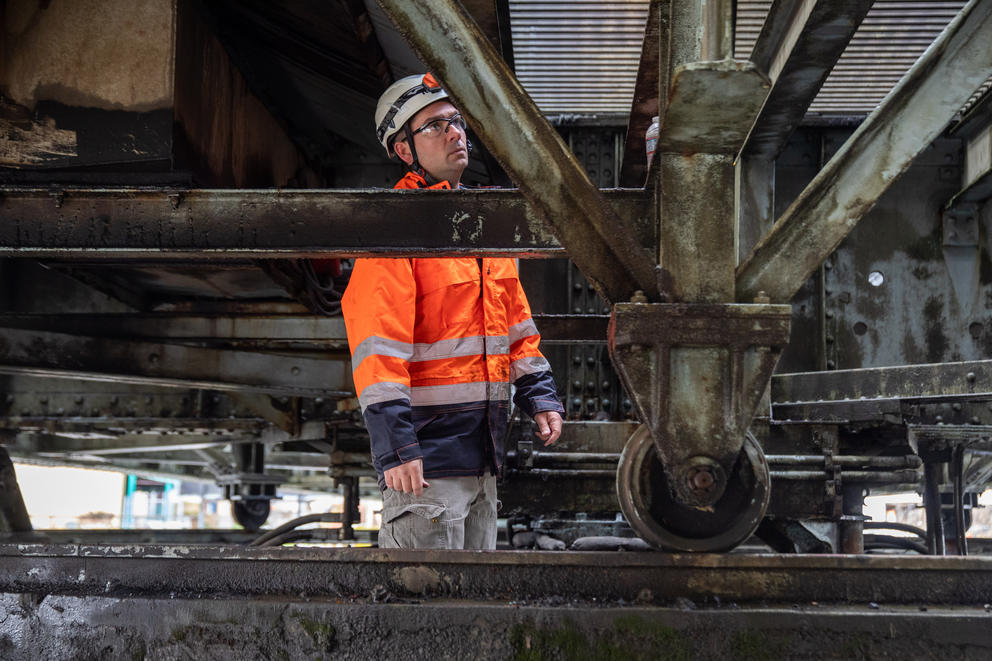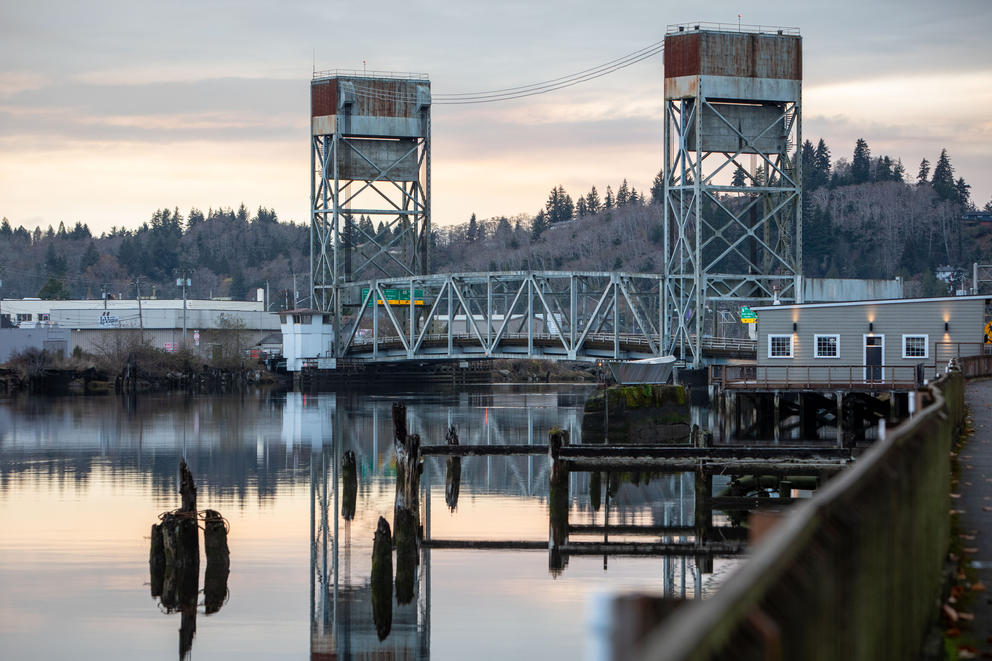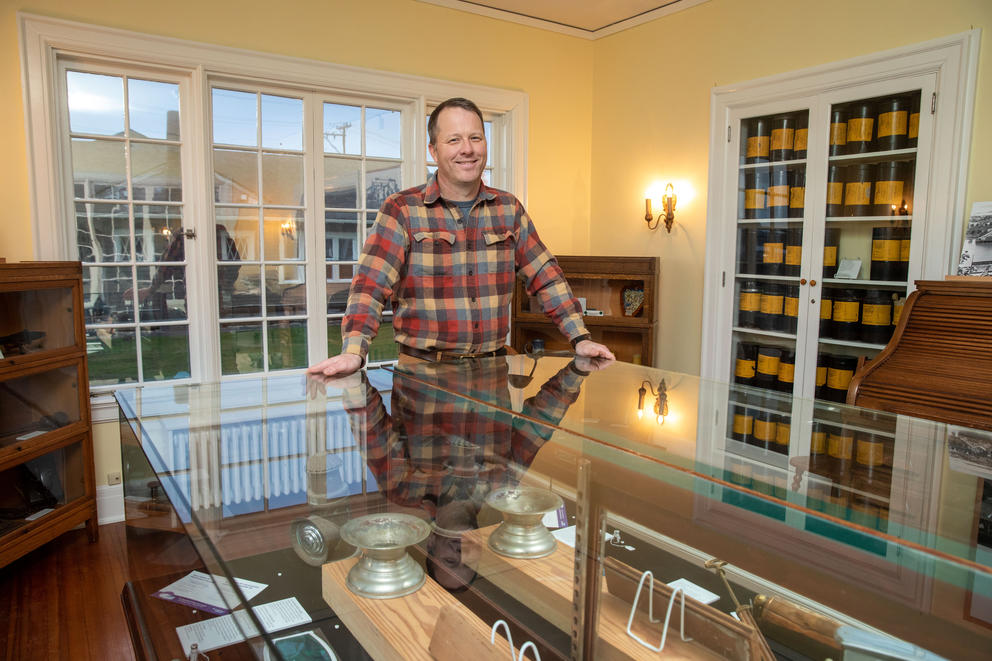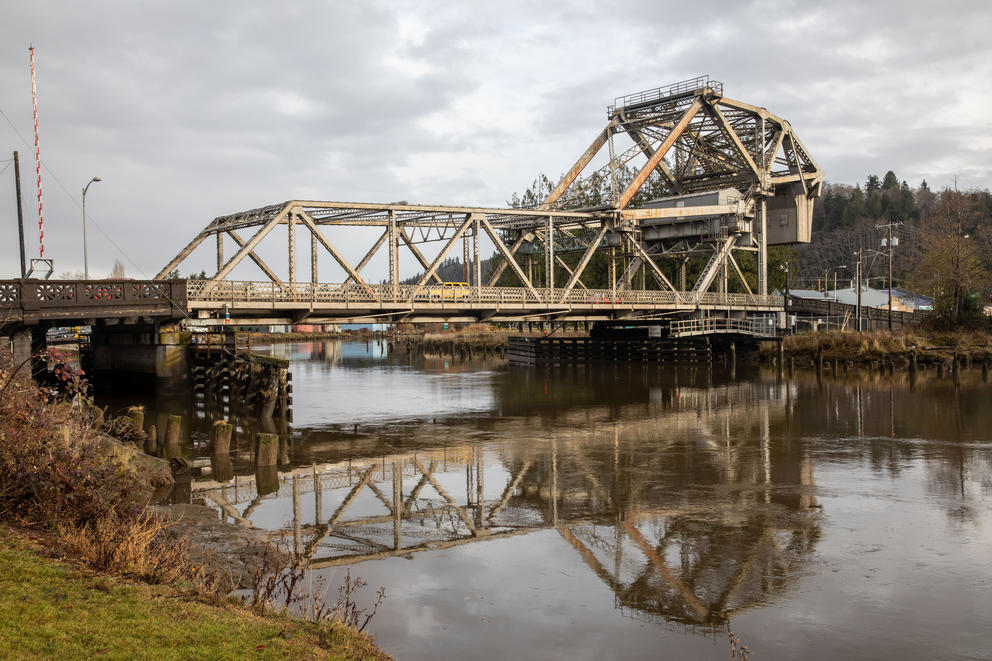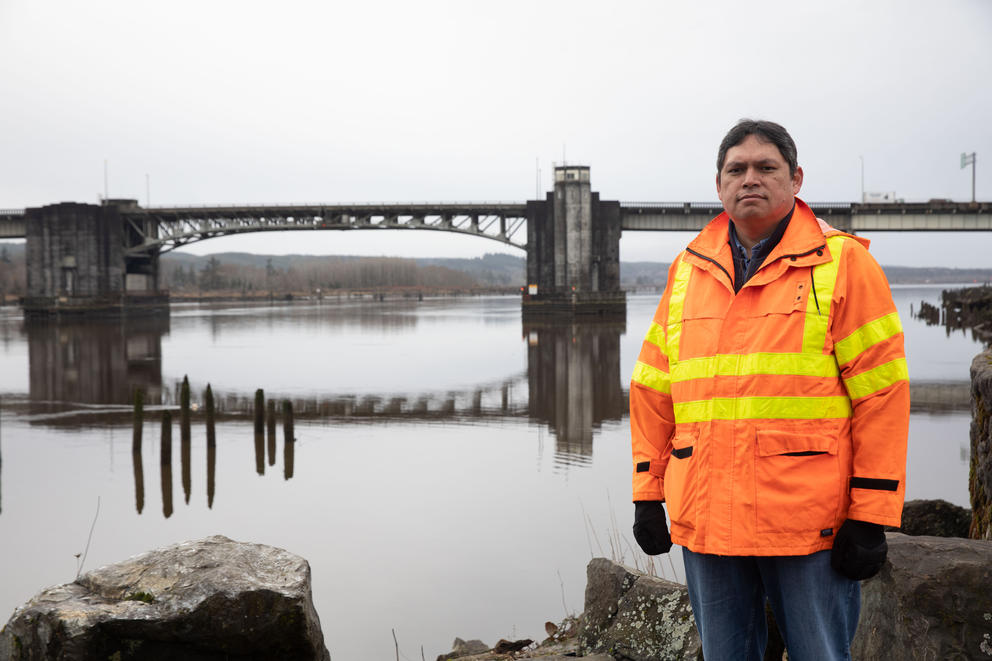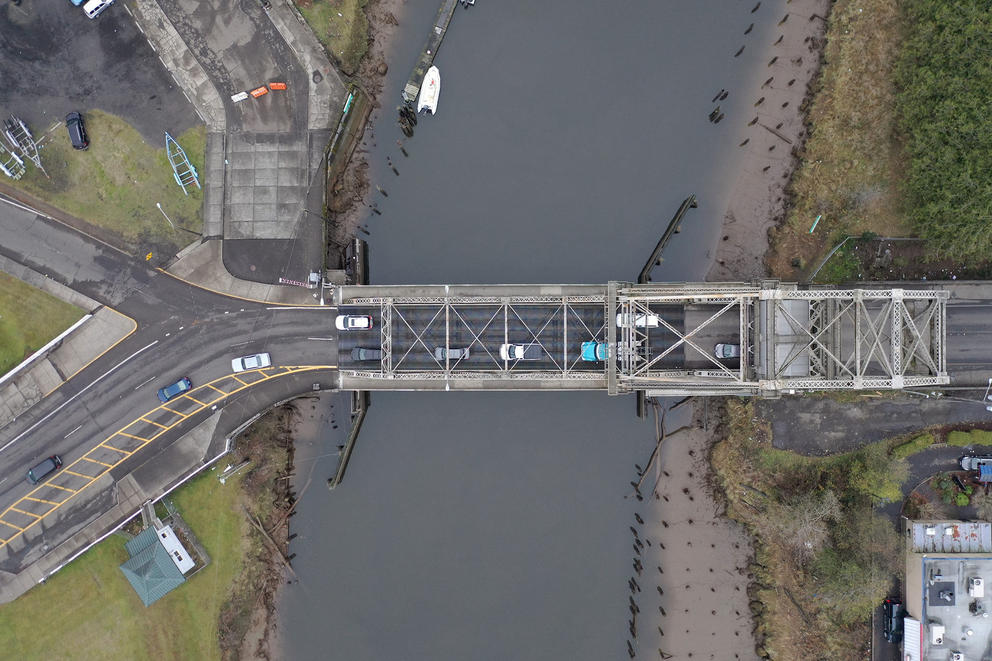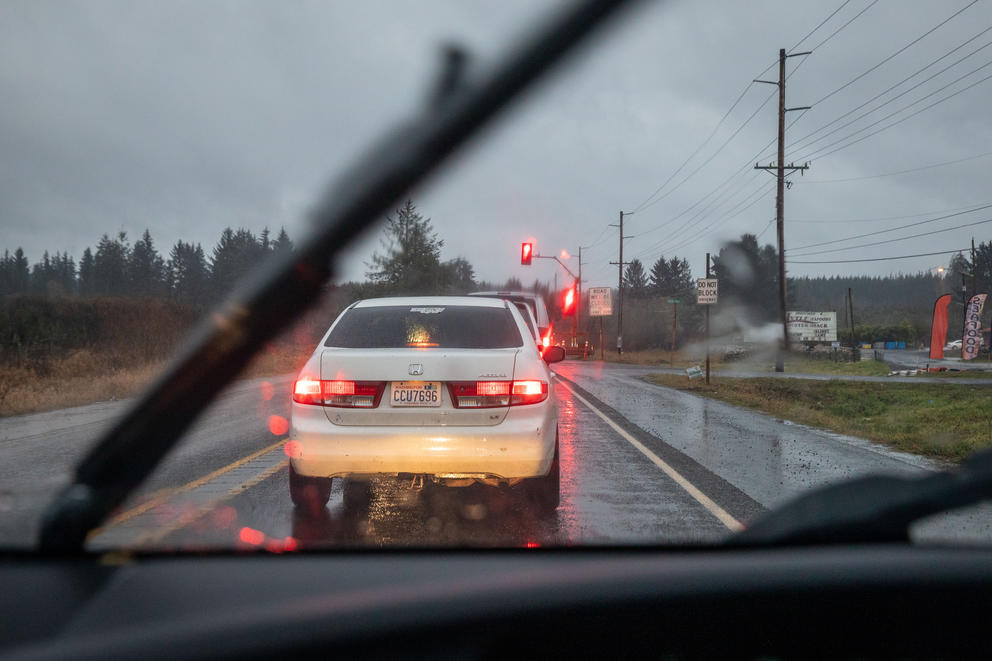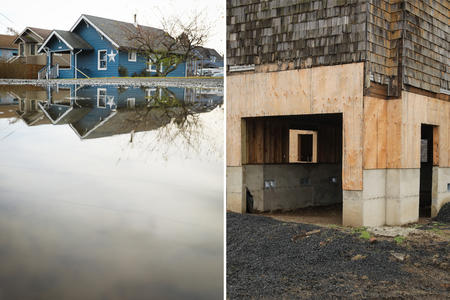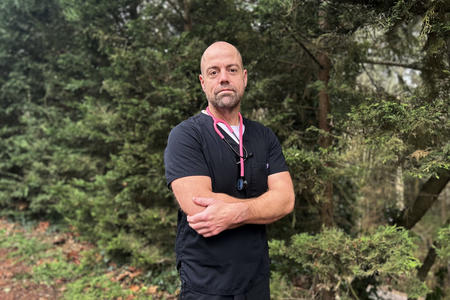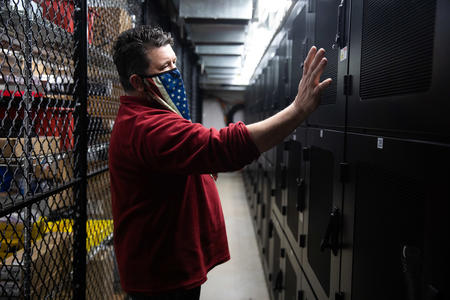Staying within a couple feet of the steel girders, the engineer and supervisor of special structures for the Washington State Department of Transportation slowly scanned the rivets connecting the deck to the piers. Unhurried, Tatum searched for signs of corrosion and cracks on the swing bridge.
Bridge inspections often require squeezing into narrow spaces under substructures or dangling from a bucket truck below a bridge deck to get a closer look.
“There's also a lot of action connected with our job,” said Tatum, one of 40 full-time inspectors at WSDOT who monitor about two-thirds of the roughly 10,000 bridges around the state. “We may be hanging hundreds of feet above the roadway or the water suspended from ropes to do our work.”
“You really have to push yourself into uncomfortable places in order to see what the bridge is doing,” according to Colt Tatum, an engineer and supervisor of special structures for the Washington State Department of Transportation, as he examines Aberdeen's Heron Street Bridge. (Lizz Giordano/Crosscut)
Public inspection data shows about 530 of the state’s bridges are classified in “poor” condition, the agency’s lowest assessment. In Grays Harbor County, where the Heron Street Bridge crosses the Wishkah River, records show even greater deterioration: Nearly one out of 10 bridges are listed in poor condition, including several highly trafficked spans near downtown Aberdeen and Hoquiam.
This is the second story in a three-part series on infrastructure in Grays Harbor County from Crosscut’s WA Recovery Watch, an investigative project tracking federal dollars in Washington state.
Delays in overdue repair or maintenance work can lead to emergency closures that sometimes have deep economic repercussions for communities and businesses. A $605 million boost in federal funds that began flowing into Washington last year will help the state make a dent in its growing list of bridge maintenance and replacement work.
But even with additional money from the $1.2 trillion Bipartisan Infrastructure Law on top of what the state already invests each year, officials say it still won’t be enough to address all of Washington’s bridges rated in poor condition.
Just catching up on repairs to state-owned bridges, transportation officials estimate, would take more than $150 million annually.
“We assume the backlog will remain,” WSDOT spokesperson Christina Werner said, “and, without a new fund source, will increase.”
A path across
Swirling through Grays Harbor County, river channels and waterways define the region. The Chehalis River and its tributaries bisect the area, snaking among cities that sprung up during the booming timber days and emptying into the Pacific Ocean. Concrete, steel and sometimes wooden bridges serve as essential connections of both people and place.
“To have that much water means you've got some barriers that you’re not easily able to traverse if you're looking to go overland,” said John Larson, director of the Polson Museum in Hoquiam. “You're going to need to put a bridge here and there to make yourself float, to make yourself be able to move from point A to point B.”
Today, a variety of structures dot the county’s landscape: Bascule bridges use counterweights to open a center span, swing bridges rotate to allow boats to pass, and a vertical lift bridge rises like an elevator. The constraints of a particular location combined with inventive engineering have erected a unique assortment over the past century.
In the county’s largest city, WSDOT’s Tatum scrutinized each beam supporting the Heron Street Bridge, one of Aberdeen's busiest crossings. He examined a previous repair that welded a T-shaped steel piece to shore up a fissure on a beam that connects the substructure to the deck. He kept careful not to stray too far from the steel girders.
“They tell you to be at arm’s reach, then you’re pretty well guaranteed you're gonna see everything that's up there,” he said. “It makes you slow down and really look at the structure.”
Every bridge receives an inspection roughly every two years. Crews typically examine three areas: the superstructure, which includes the deck and supporting girders; the substructure or foundational elements; and any mechanical parts if it’s a movable bridge. Inspection teams often check 20 to 30 structures a week, which can take anywhere from a few hours to several days each to complete depending on the size of the bridge and crew.
Any number of things can cause deterioration, Tatum said. The number of vehicles moving across a bridge each day, water seeping into cracks or the movement of rivers underneath the bridge can all wear on its structure.
But, he noted, not all cracks indicate a problem.
“A stable crack that's not changing at all is going to be inherently of lesser concern than a crack that is opening up and changing over time,” Tatum said. “But certainly if it is a quarter-inch two years ago and three inches now, that crack has grown substantially. That's something that we need to be very keyed into.”
WSDOT uses past reports to check for growth by measuring, photographing and tracing cracks with paint.
Seattleites, particularly those in West Seattle, are very familiar with precarious cracks. Rapidly growing fractures unexpectedly closed, in 2020, the high bridge that connected the peninsula to the rest of the city. This emergency closure happened as stay-at-home orders came down in the early days of the pandemic. The city spent two years scrambling to repair the bridge.
After repairs, the bridge’s rating is listed as fair. In King County, just under 5% of the roughly 1,700 bridges are considered to be in poor condition.
A separate team inspects bridges’ substructures checking for scour — the action of the river channel washing material away and eating away the foundation. Scour can also be the addition of material being deposited around pilings.
Scour put the Simpson Avenue Bridge in Hoquiam out of commission in 2010 after deterioration on its timber pilings went unnoticed for years. The emergency closure lasted about six months on a major route used by locals, clam diggers and tourists headed for Washington coastal beaches. Today the bridge, rated in poor condition, once again needs repairs.
“It’s the primary issue across the board that’s caused bridge failures,” Tatum explained. “Rivers are tremendously powerful and they’re always moving. So you always have that potential to erode the foundations.”
The lower the rating of a bridge's condition, the higher it is placed on the repair or replacement list, according to Roman Peralta, co-chair of WSDOT’s Bridge Preservation Office. He is pictured here near the longest bridge in Grays Harbor County, the Chehalis River Bridge, which is nearly half a mile long. (Lizz Giordano/Crosscut)
Backlog of repairs
WSDOT monitors roughly 7,300 bridges around the state. The agency owns about half of those, contracting with over 100 local municipalities to inspect the others. Local city or county crews handle the rest.
All agencies inspecting bridges in Washington follow the same basic process, outlined in detail in WSDOT’s manual. Once an inspection is completed, the deck — the superstructure that supports the roadway and the substructure — is given a numerical score, which is then compiled into an overall condition rating.
A nine or an eight indicates the bridge is in excellent condition, according to Roman Peralta, co-chair of WSDOT’s Bridge Preservation Office; a zero score closes the bridge. A bridge with a rating of 4 or less is given a rating of poor. The inspection team then makes repair recommendations, which could include preservation or replacement.
Of Washington’s 39 counties, Grays Harbor has the sixth highest percentage of bridges rated in poor condition. Some counties have an even greater backlog of bridge maintenance — in Pend Oreille and Stevens counties, roughly one out of six bridges is rated as poor. Island and San Juan counties, meanwhile, each with fewer than 15 bridges total, have none rated in poor condition.
Overall, 17 Washington counties have at least 5% of their bridges deemed in poor condition.
A rating of poor doesn’t mean it’s unsafe or structurally deficient, Peralta said. The agency has protocols for immediately shutting down bridges considered unsafe or at risk of failure based on the inspections and accompanied analysis.
Generally, a lower rating places a bridge higher on the repair or replacement list, Peralta explained. When its rating drops into the poor category, a bridge becomes eligible for replacement.
The goal is for WSDOT to address the needs of all bridges rated in poor condition or in need of maintenance work, Peralta said, so crews can focus on preventative work.
But that day is still long in the future, despite the $605.1 million flowing into Washington from the Bridge Formula program rolled up in the Bipartisan Infrastructure Law. Touted as “the single largest dedicated bridge investment since the construction of the interstate highway system,” the program is sending $27.5 billion to states for bridge rehabilitation, preservation or replacement work.
The federal government requires that 75% of this funding must go to bridges classified in poor condition. Another $12.5 billion from the bill will be available through a competitive grant process.
The Washington Legislature’s Joint Transportation Committee decided last year that 61% of the state’s portion of the federal money will go to state-owned bridges. The rest will head to cities and counties.
Find tools and resources in Crosscut’s Follow the Funds guide to track down federal recovery spending in your community.
Despite an additional $369 million boost for state-owned bridges, a 60% funding gap will still exist, according to Werner at WSDOT, “given that WSDOT is annually short approximately $150-$200 million in bridge preservation funding compared to needs,” she wrote in an email.
Werner explained that for the portion of federal money going to state-owned bridges, priority will be given to bridges crossing state lines, movable bridges, those on strategic freight routes and those with the highest daily truck traffic.
WSDOT’s Local Programs Office will administer the local funds over the next five years. According to the program’s latest call for projects, bridges with a deck, superstructure, or substructures with a rating of 4 or less were eligible for the funding.
Fabric of a community
Rebuilt several times, remnants of past Heron Street Bridges sit among the piers supporting the current one in downtown Aberdeen. The swing bridge sits parallel to the Wishkah River Bridge, a bascule-style structure constructed in 1925 which carries traffic heading the opposite direction. They have carried timber, freight and tourists across the Wishkah River, a tributary of the Chehalis that cuts through Aberdeen, for decades.
Larson, the Hoquiam museum director, said he hopes many of these old bridges stick around. They have become part of the fabric of a community.
“You see structures like that being built, because people had this upward and onward vision of how they anticipated their communities to grow,” he said. “Now if you're a bean counter on the maintenance side of things on a bridge, you're gonna look at preserving a bridge as a much cheaper option than tearing it down and building a brand-new bridge.”
Both the Heron Street and Wishkah River bridges are now rated in poor condition. Hoping to avert last-minute repairs on one of the county’s most trafficked crossings, the Wishkah River Bridge is scheduled for maintenance on its mechanical components in the summer of 2025. The Heron Street Bridge is on the list for replacement but no date has been set, according to WSDOT.
While the bridges of Grays Harbor no longer open as frequently for large timber shipments or other maritime traffic, the county’s cities increasingly rely on bridges to carry goods or tourists to the beach. A closure can mean long detours for drivers. And emergency closures give cities little time to plan or businesses to prepare.
The critical connections that bridges provide are perhaps never more apparent than when they’re gone.
Drivers heading toward Hoquiam wait for their turn to cross the Grass Creek Bridge along State Route 109. The key link between Ocean Shores partially closed last May after inspectors found advanced degradation of timber pilings under the southbound lane of the bridge.The bridge is completely closed as WSDOT makes repairs. (Lizz Giordano for Crosscut)
Last May, WSDOT closed one lane of the Grass Creek Bridge along State Route 109, a key link between Hoquiam and Ocean Shores, after inspectors found advanced degradation of timber pilings under the southbound lane of the bridge.
The lane closure happened on Lytle Seafoods’ doorstep just as the oyster farm’s busiest season began. Their waterside shack sits less than 300 feet from the Grass Creek Bridge.
Owner Mike Lytle said that on busy summer days, it took cars 30 minutes to get through the one-way closure.
“They didn’t want to turn in here cause they figured they were going to get stuck,” he said.
And as holiday shopping ramped up, the state started repairs on the bridge, closing it entirely and rerouting cars along a 13-mile detour. Work was scheduled to last up to 10 weeks, but crews wrapped up early and WSDOT reopened in the middle of January. Lytle’s December business was a fraction of that of last year. He said he hadn’t bothered opening on the weekends.
“It’s killing business,” he said in an interview during the recent closure. “I get one or two people a day if I’m lucky. … There's no reason to be open, there are no customers.”
Get the latest investigative news
A newsletter for resources, data and behind-the-scenes insight into investigative efforts.

